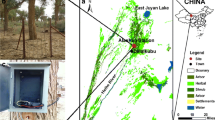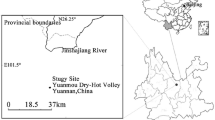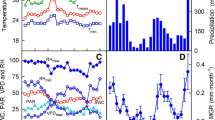Abstract
The critical zone (CZ) represents the intersection of the biosphere with the atmosphere, hydrosphere and lithosphere. Understanding the hydrological processes and human impact factors on the CZ is fundamental to sustainable water resources management for agroforestry. Transpiration (T) is an important component of terrestrial evapotranspiration (ET), and understanding the time lag (TL) between vegetation transpiration and meteorological factors can improve our knowledge of the mechanisms of vegetation adaptability to a changing environment. However, the controlling factors on the TL remain poorly understood. Therefore, the objective of this study is identifying the temporal dynamics of key controlling factors on the TL, using a typical deciduous broad-leaved tree species (Zenia insigins Chun) of CZ in subtropical humid karst regions. This species is used as an example to explore the characteristics of the TL between SF (sap flow) and hydro-meteorological forcing. Sap flow in these 6 trees was monitored using the thermal dissipation probes (TDP). Results showed that: (1) the peak of diurnal sap flow generally lagged behind PAR but preceded Ta (air temperature), RH (relative humidity) and VPD (vapor pressure deficit), with the mean TL of −67.4 min (PAR), 90.5 min (Ta), 91.6 min (RH) and 92.9 min (VPD), respectively; (2) TL had no significant relationships with the daily mean meteorological factors and soil moisture, but was highly (R2>0.66) correlated to CRs (changing rates of meteorological factors) in the morning; (3) At seasonal scale, the sap flow rate and TL both were controlled by the seasonality of precipitation and temperature. Overall, the seasonality of the TL was caused by plants’ high water loss and strongly active physiological response in hot seasons, leading to close stomata earlier than in cold seasons; (4) The reason why CRs proposed can explain the TL better than mean values of metrological factors is that the CRs considered the distribution and change processes of metrological factors in the daytime. This study may be helpful for understanding the physiological response of vegetation to climatic change, and may be useful for constructing models to simulate transpiration processes more accurately during a day.
Similar content being viewed by others
References
Agam N, Kustas W P, Evett S R, Colaizzi P D, Cosh M H, McKee L G. 2012. Soil heat flux variability influenced by row direction in irrigated cotton. Adv Water Resour, 50: 31–40
Allen C D, Breshears D D. 1998. Drought-induced shift of a forestwoodland ecotone: Rapid landscape response to climate variation. Proc Natl Acad Sci USA, 95: 14839–14842
Anderson R S. 2015. Pinched topography initiates the critical zone. Science, 350: 506–507
Aubrecht L, Stanek Z, Koller J. 2006. Electrical measurement of the absorption surfaces of tree roots by the earth impedance method: 1. Theory. Tree Physiol, 26: 1105–1112
Bai Y, Zhu G, Su Y, Zhang K, Han T, Ma J, Wang W, Ma T, Feng L. 2015. Hysteresis loops between canopy conductance of grapevines and meteorological variables in an oasis ecosystem. Agric For Meteorol, 214-215: 319–327
Bosch D D, Marshall L K, Teskey R. 2014. Forest transpiration from sap flux density measurements in a Southeastern Coastal Plain riparian buffer system. Agric For Meteorol, 187: 72–82
Brooks P D, Chorover J, Fan Y, Godsey S E, Maxwell R M, McNamara J P, Tague C. 2015. Hydrological partitioning in the critical zone: Recent advances and opportunities for developing transferable understanding of water cycle dynamics. Water Resour Res, 51: 6973–6987
Chen L, Zhang Z, Li Z, Tang J, Caldwell P, Zhang W. 2011. Biophysical control of whole tree transpiration under an urban environment in Northern China. J Hydrol, 402: 388–400
Chorover J, Derry L A, McDowell W H. 2017. Concentration-discharge relations in the critical zone: Implications for resolving critical zone structure, function, and evolution. Water Resour Res, 53: 8654–8659
Cramer V A, Thorburn P J, Fraser G W. 1999. Transpiration and groundwater uptake from farm forest plots of Casuarina glauca and Eucalyptus camaldulensis in saline areas of southeast Queensland, Australia. Agric Water Manage, 39: 187–204
Drake J E, Davis S C, Raetz L M, Delucia E H. 2011. Mechanisms of agerelated changes in forest production: The influence of physiological and successional changes. Glob Change Biol, 17: 1522–1535
Du H, Zeng F, Peng W, Wang K, Zhang H, Liu L, Song T. 2015. Carbon storage in a eucalyptus plantation chronosequence in Southern China. Forests, 6: 1763–1778
Du S, Wang Y L, Kume T, Zhang J G, Otsuki K, Yamanaka N, Liu G B. 2011. Sapflow characteristics and climatic responses in three forest species in the semiarid Loess Plateau region of China. Agric For Meteorol, 151: 1–10
Ewers B E, Gower S T, Bond-lamberty B, Wang C K. 2005. Effects of stand age and tree species on canopy transpiration and average stomatal conductance of boreal forests. Plant Cell Environ, 28: 660–678
Fiora A, Cescatti A. 2006. Diurnal and seasonal variability in radial distribution of sap flux density: Implications for estimating stand transpiration. Tree Physiol, 26: 1217–1225
Forrester D I, Collopy J J, Morris J D. 2010. Transpiration along an age series of Eucalyptus globulus plantations in southeastern Australia. For Ecol Manage, 259: 1754–1760
Granier A. 1985. Une nouvelle méthode pour la mesure du flux de sève brute dans le tronc des arbres. Ann For Sci, 42: 193–200
Granier A, Biron P, Breda N, Pontailler J Y, Saugier B. 1996. Transpiration of trees and forest stands: Short and long-term monitoring using sapflow methods. Glob Change Biol, 2: 265–274
Granier A, Biron P, Lemoine D. 2000. Water balance, transpiration and canopy conductance in two beech stands. Agric For Meteorol, 100: 291–308
Holbrook N M, Sinclair T R. 1992. Water balance in the arborescent palm, Sabal palmetto. II. Transpiration and stem water storage. Plant Cell Environ, 15: 401–409
Hubbard R M, Ryan M G, Giardina C P, Barnard H. 2004. The effect of fertilization on sap flux and canopy conductance in a Eucalyptus saligna experimental forest. Glob Change Biol, 10: 427–436
Ivanov V Y, Fatichi S, Jenerette G D, Espeleta J F, Troch P A, Huxman T E. 2010. Hysteresis of soil moisture spatial heterogeneity and the “homogenizing” effect of vegetation. Water Resour Res, 46: W09521
Janssen R H H, Meinders M B J, van Nes E H, Scheffer M. 2008. Mi-croscale vegetation-soil feedback boosts hysteresis in a regional vegetation- climate system. Glob Change Biol, 14: 1104–1112
Jasechko S, Sharp Z D, Gibson J J, Birks S J, Yi Y, Fawcett P J. 2013. Terrestrial water fluxes dominated by transpiration. Nature, 496: 347–350
Kang S, Liu X. 1993. Distribution of hydraulic resistance and water potential in soil-plant-atmosphere continuum during growing period of maize. J Appl Ecol, 4: 260–266
Kang S, Xiong Y, Wang Z. 1990. Distribution of hydraulic resistance and water potential in soil-plant-atmophere contimuum. J Hydraul Eng Asce, (7): 1–9
Kite G. 2000. Using a basin-scale hydrological model to estimate crop transpiration and soil evaporation. J Hydrol, 229: 59–69
Li W, Yu T F, Li X Y, Zhao C Y. 2016. Sap flow characteristics and their response to environmental variables in a desert riparian forest along lower Heihe River Basin, Northwest China. Environ Monit Assess, 188: 561
Lin H. 2010. Earth’s Critical Zone and hydropedology: Concepts, characteristics, and advances. Hydrol Earth Syst Sci, 14: 25–45
Liu M X, Xu X L, Wang D B, Sun A Y, Wang K L. 2016. Karst catchments exhibited higher degradation stress from climate change than the nonkarst catchments in southwest China: An ecohydrological perspective. J Hydrol, 535: 173–180
Ma L, Lu P, Zhao P, Rao X, Cai X, Zeng X. 2008. Diurnal, daily, seasonal and annual patterns of sap-flux-scaled transpiration from an Acacia mangium plantation in South China. Ann For Sci, 65: 402
Meinzer F C, Goldstein G, Franco A C, Bustamante M, Igler E, Jackson P, Caldas L, Rundel P W. 1999. Atmospheric and hydraulic limitations on transpiration in Brazilian cerrado woody species. Funct Ecol, 13: 273–282
Mualem Y. 1974. A conceptual model of hysteresis. Water Resour Res, 10: 514–520
Nie Y P, Chen H S, Wang K L, Yang J. 2012. Water source utilization by woody plants growing on dolomite outcrops and nearby soils during dry seasons in karst region of Southwest China. J Hydrol, 420-421: 264–274
O’brien J J, Oberbauer S F, Clark D B. 2004. Whole tree xylem sap flow responses to multiple environmental variables in a wet tropical forest. Plant Cell Environ, 27: 551–567
O’Grady A P, Eamus D, Hutley L B. 1999. Transpiration increases during the dry season: Patterns of tree water use in eucalypt open-forests of northern Australia. Tree Physiol, 19: 591–597
O’Grady A P, Worledge D, Battaglia M. 2008. Constraints on transpiration of Eucalyptus globulus in southern Tasmania, Australia. Agric For Meteorol, 148: 453–465
Oguntunde P G. 2005. Whole-plant water use and canopy conductance of cassava under limited available soil water and varying evaporative demand. Plant Soil, 278: 371–383
Peng W, Song T, Zeng F, Wang K, Du H, Lu S. 2013. Spatial distribution of surface soil water content under different vegetation types in northwest Guangxi, China. Environ Earth Sci, 69: 2699–2708
Rong L, Chen X, Chen X, Wang S, Du X. 2011. Isotopic analysis of water sources of mountainous plant uptake in a karst plateau of southwest China. Hydrol Process, 25: 3666–3675
Schulze E D, Cermák J, Matyssek M, Penka M, Zimmermann R, Vasícek F, Gries W, Kucera J. 1985. Canopy transpiration and water fluxes in the xylem of the trunk of Larix and Picea trees—A comparison of xylem flow, porometer and cuvette measurements. Oecologia, 66: 475–483
Schwinning S. 2008. The water relations of two evergreen tree species in a karst savanna. Oecologia, 158: 373–383
Sperry A. 2000. Wagons westward: The old trail to Santa Fe. In: Godine D R, ed. Boston. 200
Sun D, Guan X D, Yuan F H, Wang Z A, Wu J B. 2010. Time lag effect between poplar’s sap flow velocity and microclimate factors in agroforestry system in West Liaoning Province. J Appl Ecol, 21: 2742–2748
Sun T, Wang Z H, Ni G H. 2013. Revisiting the hysteresis effect in surface energy budgets. Geophys Res Lett, 40: 1741–1747
Tuzet A, Perrier A, Leuning R. 2003. A coupled model of stomatal conductance, photosynthesis and transpiration. Plant Cell Environ, 26: 1097–1116
Uddin J, Smith R J, Hancock N H, Foley J P. 2013. Evaporation and sapflow dynamics during sprinkler irrigation of cotton. Agric Water Manage, 125: 35–45
Unsworth M H, Phillips N, Link T, Bond B J, Falk M, Harmon M E, Hinckley T M, Marks D, Paw U K T. 2004. Components and controls of water flux in an old-growth douglas-fir-western hemlock ecosystem. Ecosystems, 7: 468–481
Wang H, Ouyang Z, Zheng H, Wang X, Ni Y, Ren Y. 2009. Time lag characteristics of stemsap flow of common tree species during their growing season in Beijing downtown. J Appl Ecol, 20: 2111–2117
Wang H M, Sun W, Zu Y G, Wang W J. 2011. Complexity and its integrative effects of the time lags of environment factors affecting Larix gmelinii stem sap flow. J Appl Ecol, 22: 3109–3116
Wang X F, Liu J F, Sun Y Y, Li K, Zhang C H. 2017. Sap flow characteristics of three afforestation species during the wet and dry seasons in a dry-hot valley in Southwest China. J For Res, 28: 51–62
Waring R H, Running S W. 1978. Sapwood water storage: Its contribution to transpiration and effect upon water conductance through the stems of old-growth Douglas-Fir. Plant Cell Environ, 1: 131–140
Wei Z, Yoshimura K, Wang L, Miralles D G, Jasechko S, Lee X. 2017. Revisiting the contribution of transpiration to global terrestrial evapotranspiration. Geophys Res Lett, 44: 2792–2801
Wullschleger S D, Hanson P J, Tschaplinski T J. 1998. Whole-plant water flux in understory red maple exposed to altered precipitation regimes. Tree Physiol, 18: 71–79
Yang J, Xu X, Liu M, Xu C, Luo W, Song T, Du H, Kiely G. 2016. Effects of Napier grass management on soil hydrologic functions in a karst landscape, southwestern China. Soil Tillage Res, 157: 83–92
Yang J, Xu X, Liu M, Xu C, Zhang Y, Luo W, Zhang R, Li X, Kiely G, Wang K. 2017. Effects of “Grain for Green” program on soil hydrologic functions in karst landscapes, southwestern China. Agriculture Ecosyst Environ, 247: 120–129
Zeppel M J B, Murray B R, Barton C, Eamus D. 2004. Seasonal responses of xylem sap velocity to VPD and solar radiation during drought in a stand of native trees in temperate Australia. Funct Plant Biol, 31: 461–470
Zhang Q, Manzoni S, Katul G, Porporato A, Yang D. 2014. The hysteretic evapotranspiration-Vapor pressure deficit relation. J Geophys Res- Biogeosci, 119: 125–140
Zhao P, Lu P, Ma L, Sun G, Rao X, Cai X, Zeng X. 2005. Combining sap flow measurement-based canopy stomatal conductance and 13C discrimination to estimate forest carbon assimilation. Chin Sci Bull, 50: 2021–2027
Zhao P, Rao X Q, Ma L, Cai X A. 2006. The variations of sap flux density and whole-tree transpiration across individuals of Acacia mangium. Acta Ecol Sin, 26: 4050–4058
Zhao X, Liu J, Xia X, Chu J, Wei Y, Shi S, Chang E, Yin W, Jiang Z. 2014. The evaluation of heavy metal accumulation and application of a comprehensive bio-concentration index for woody species on contaminated sites in Hunan, China. Environ Sci Pollut Res, 21: 5076–5085
Acknowledgements
We thank two anonymous reviewers. This study was supported by the National Natural Science Foundation of China (Grant Nos. 41571130073 & 41501042), the Youth Innovation Team Project of ISA, CAS (Grant No. 2017QNCXTD_XXL), and the CAS Interdisciplinary Innovation Team.
Author information
Authors and Affiliations
Corresponding author
Rights and permissions
About this article
Cite this article
Zhang, R., Xu, X., Liu, M. et al. Hysteresis in sap flow and its controlling mechanisms for a deciduous broad-leaved tree species in a humid karst region. Sci. China Earth Sci. 62, 1744–1755 (2019). https://doi.org/10.1007/s11430-018-9294-5
Received:
Revised:
Accepted:
Published:
Issue Date:
DOI: https://doi.org/10.1007/s11430-018-9294-5




